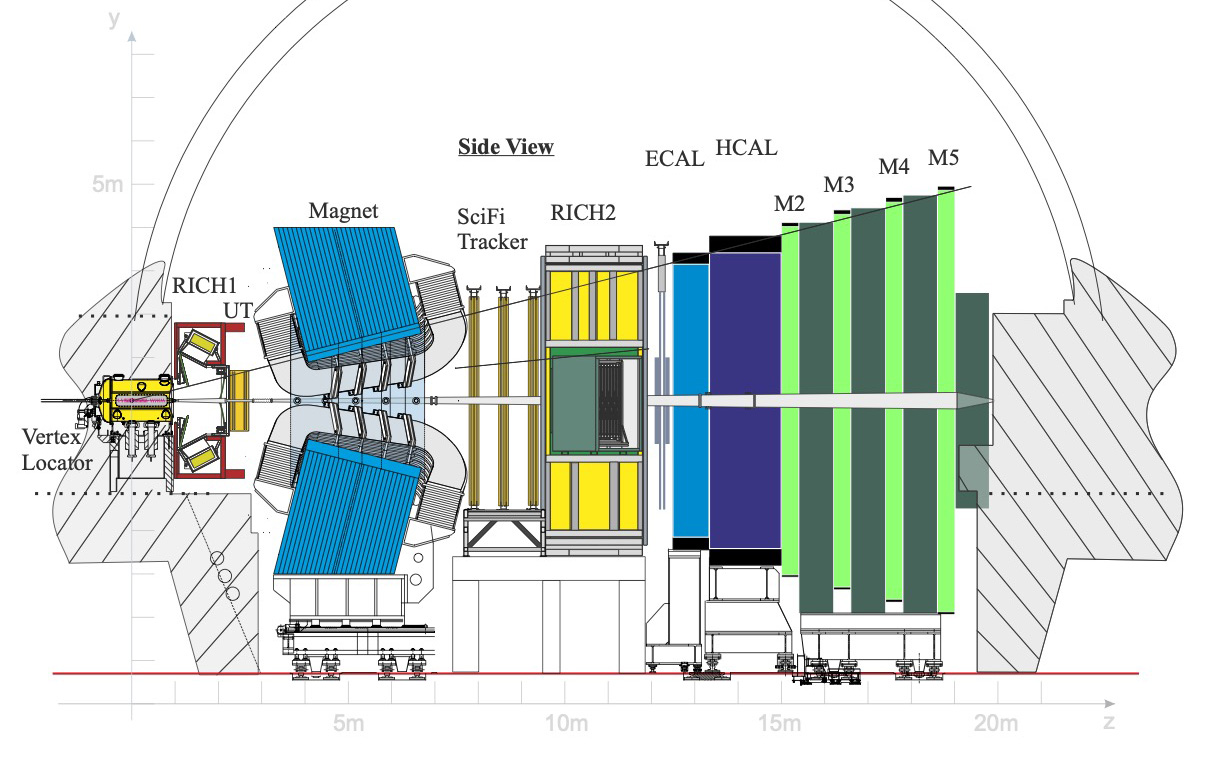 13.8 billions years ago, equal quantities of matter and antimatter were created during the Big Bang. After only 1 second, while the Universe was cooling and expanding, antimatter had almost disappeared, allowing matter to form everything around us: stars, planets and, eventually, life. The LHCb experiment, located 100m underground at the French-Swiss border, investigates the mystery of the antimatter’s vanishing by exploring the physics of particles made of b (beauty) and c (charm) quarks. LHCb is one of the four biggest experiments operating at the Large Hadron Collider (LHC) at CERN. The LHCb experiment is an international collaboration of around 1400 members from 90 institutes in 20 countries across the globe. The geometry of the LHCb detector is based on the fact that hadrons made of b and c quarks are predominantly produced in the forward (or backward) cone around the direction of the proton beams. The detector is made of a series of sub-detectors, each having a specific task:
13.8 billions years ago, equal quantities of matter and antimatter were created during the Big Bang. After only 1 second, while the Universe was cooling and expanding, antimatter had almost disappeared, allowing matter to form everything around us: stars, planets and, eventually, life. The LHCb experiment, located 100m underground at the French-Swiss border, investigates the mystery of the antimatter’s vanishing by exploring the physics of particles made of b (beauty) and c (charm) quarks. LHCb is one of the four biggest experiments operating at the Large Hadron Collider (LHC) at CERN. The LHCb experiment is an international collaboration of around 1400 members from 90 institutes in 20 countries across the globe. The geometry of the LHCb detector is based on the fact that hadrons made of b and c quarks are predominantly produced in the forward (or backward) cone around the direction of the proton beams. The detector is made of a series of sub-detectors, each having a specific task:
- The Vertex Locator (called VELO) is placed at the proton-proton interaction point of the LHC. It is a silicon detector allowing a precise reconstruction of the hadrons’ decay vertices, as well as the collision point.
- RICH1 and RICH2 are detectors based on the Cherenkov effect. They allow for identification and separation of different types of charged particles.
- The Upstream Tracker, UT, together with T1, T2 and T3 tracking stations made of scintillating fibers (SciFi) provide reconstruction of the tracks left by charged particles. The LPHE group participated to the development and supports the operation of the SciFi tracker.
- The magnet placed between the UT and SciFi stations bends the trajectories of the charged particles to obtain a precise measurement of their momentum.
- The electromagnetic calorimeters (ECAL) and hadronic calorimeters (HCAL) are necessary to measure the energy of the electrons, photons and hadrons. They also contribute to particle identification.
- The muon stations M2-M5 identify the muons, which are the only particles capable of traversing the ECAL and HCAL absorbers.
- Additional small subdetectors for luminosity measurement (PLUME) and detector safety (BCM).

The LHCb Detector (Upgrade I)
The research program of the LHCb collaboration is very diverse, and includes:
- Measurements of the CP violation parameters in the decays of particles made of b and c quarks.
- Study of « conventional » hadrons (mesons and baryons), as well as « exotic » hadrons made of more than 3 quarks, called tetraquarks (4 quarks) and pentaquarks (5 quarks). LHCb has discovered dozens of new hadron states, both conventional and exotic.
- Search for rare decays (processes that are very suppressed in the Standard Model).
- Tests of symmetries of the Standard Model, such as lepton universality.
- Search for new fundamental particles or interactions through direct and indirect measurements.
- Study of heavy-ion collisions and properties of quark-gluon plasma.